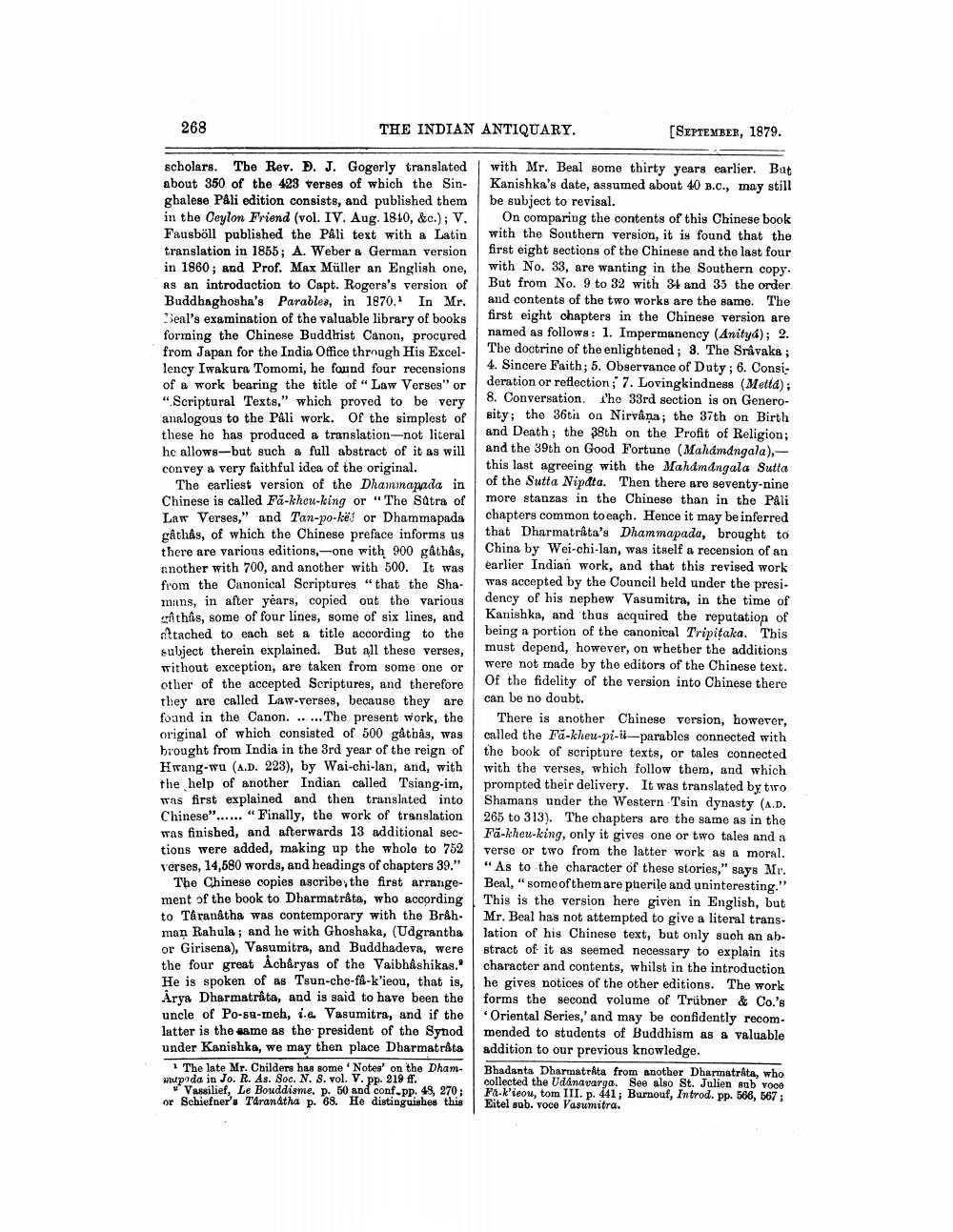________________
268
THE INDIAN ANTIQUARY.
[SEPTEMBER, 1879.
scholars. The Rev. D. J. Gogerly translated about 350 of the 423 verses of which the Singhalese PAli edition consists, and published them in the Ceylon Friend (vol. IV. Aug. 1810, &c.); V. Fausböll published the Pâli text with a Latin translation in 1855; A. Weber a German version in 1860; and Prof. Max Müller an English one, as an introduction to Capt. Rogers's version of Buddhaghosha's Parables, in 1870.1 In Mr. Seal's examination of the valuable library of books forming the Chinese Buddhist Canon, procured from Japan for the India Office through His Excellency Iwakura Tomomi, he found four recensions of a work bearing the title of "Law Verses" or "Scriptural Texts," which proved to be very analogous to the Pali work. Of the simplest of these he has produced a translation--not literal he allows--but such a full abstract of it as will convey a very faithful idea of the original.
The earliest version of the Dhammapada in Chinese is called Fă-khcu-king or "The Sutra of Law Verses," and Tan-po-kët or Dhammapada gåthås, of which the Chinese preface informs us there are various editions, --one with 900 gåthås, another with 700, and another with 500. It was from the Canonical Scriptures "that the Shamans, in after years, copied out the various cithâs, some of four lines, some of six lines, and nttached to each set a title according to the subject therein explained. But all these verses, without exception, are taken from some one or other of the accepted Scriptures, and therefore they are called Law-verses, because they are found in the Canon. ... ... The present work, the original of which consisted of 500 gåthås, was brought from India in the 3rd year of the reign of Hwang-wu (A.D. 223), by Wai-chi-lan, and, with the help of another Indian called Tsiang-im, was first explained and then translated into Chinese"......" Finally, the work of translation was finished, and afterwards 13 additional sections were added, making up the whole to 752 Verses, 14,580 words, and headings of chapters 39."
The Chinese copies ascribe, the first arrangement of the book to Dharmatråta, who according to Taranatha was contemporary with the Brahman Rahula ; and he with Ghoshaka, (Udgrantha or Girisena), Vasumitra, and Buddhadeva, were the four great Acharyas of the Vaibhashikas. He is spoken of as Tsun-che-fa-k'ieou, that is, Arya Dharmatrata, and is said to have been the uncle of Po-su-meh, i.e. Vasumitra, and if the latter is the same as the president of the Synod under Kanishka, we may then place Dharmatrata
1 The late Mr. Childers has some Notes' on the Dhammupada in Jo. R. As. Soc. N. 8. vol. V. pp. 219 ff.
Vassilief, Le Bouddisme, p. 50 and conf.pp. 49, 270; or Schiefner's Taranatha p. 68. He distinguisbes this
with Mr. Beal some thirty years earlier. But Kanishka's date, assumed about 40 B.C., may still be subject to revisal.
On comparing the contents of this Chinese book with the Southern version, it is found that the first eight sections of the Chinese and the last four with No. 33, are wanting in the Southern copy. But from No. 9 to 32 with 34 and 35 the order and contents of the two works are the same. The first eight chapters in the Chinese version are named as follows: 1. Impermanency (Anity); 2. The doctrine of the enlightened ; 3. The Srivaka ; 4. Sincere Faith; 5. Observance of Duty; 6. Consi deration or reflection; 7. Lovingkindness (Metla); 8. Conversation, l'ho 33rd section is on Generosity; the 36th on Nirvana; the 37th on Birth and Death; the 38th on the Profit of Religion; and the 39th on Good Fortune (Mahdmdngala),this last agreeing with the Mahdmdngala Sutta of the Sutta Nipata. Then there are seventy-nine more stanzas in the Chinese than in the Påli chapters common to each. Hence it may be inferred that Dharmatrata's Dhammapada, brought to China by Wei-chi-lan, was itself a recension of an earlier Indian work, and that this revised work was accepted by the Council held under the presidency of his nephew Vasumitra, in the time of Kanishka, and thus acquired the reputation of being a portion of the canonical Tripitaka. This must depend, however, on whether the additions were not made by the editors of the Chinese text. Of the fidelity of the version into Chinese there can be no doubt.
There is another Chinese version, however, called the Tă-kheu-pi-i---parables connected with the book of scripture texts, or tales connected with the verses, which follow them, and which prompted their delivery. It was translated by two Shamans under the Western Tsin dynasty (A.D. 265 to 313). The chapters are the same as in the Fă-khau-king, only it gives one or two tales and a verse or two from the latter work as a moral. "As to the character of these stories," says Mr. Benl,"some of them are puterile and uninteresting." This is the version here given in English, but Mr. Beal has not attempted to give a literal trans. lation of his Chinese text, but only such an abstract of it as seemed necessary to explain its character and contents, whilst in the introduction he gives notices of the other editions. The work forms the second volume of Trübner & Co.'s
Oriental Series,' and may be confidently recommended to students of Buddhism as & valuable addition to our previous knowledge. Bhadanta Dharmatrata from another Dharmatrata, who collected the Udanavarga. See also St. Julien aub voce FAK'icou, tom III. p. 441; Burnouf, Introd. pp. 566, 567; Eitel sub. Voce Vasumitra.




